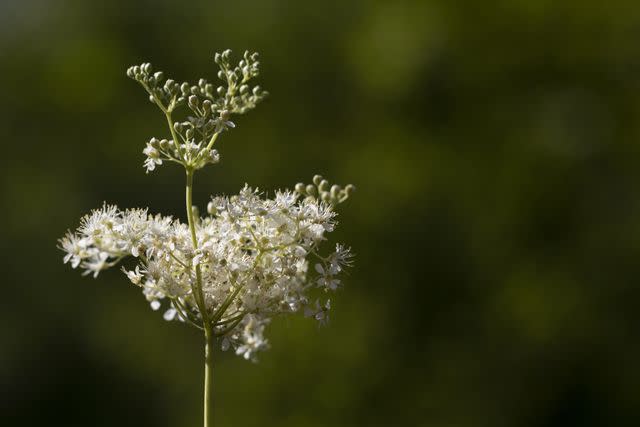Hemlock Poisoning: What to Know
Poison hemlock (Conium maculatum) is a highly toxic plant that leads to potentially fatal hemlock poisoning when touched or ingested. Native to Europe and North Africa, this biennial plant in the carrot family is now found throughout the United States and every continent except Antarctica.
Hemlock poisoning is life-threatening. Most famously, the ancient philosopher Socrates died after being forced to ingest poison hemlock. If you come into contact with the plant, you must seek medical attention right away.
This article will discuss what poison hemlock looks like, as well as the symptoms of hemlock poisoning and what to do if you think you’ve touched or consumed the plant.

Elva Etienne / Getty Images
What Does Poison Hemlock Look Like?
Often reaching heights of 3 to 8 feet, poison hemlock has long, purple-spotted stems, delicate veined leaves, and white flowers that grow in clusters known as umbels.
The poison hemlock plant is biennial, meaning that it typically grows on a two-year cycle, beginning in the early spring. It’s often found in moist environments, such as fence lines, roadsides, creeks, and fields.
Poison hemlock is often confused with other plants, such as water hemlock (Cicuta maculata) and wild parsnip (Pastinaca sativa).
Unlike poison hemlock, water hemlock, which is also toxic and potentially deadly to humans and animals, doesn’t have purple spots on its stems. Its leaves are also not as lacey and fernlike. Wild parsnip has edible roots and yellow flowers rather than white ones.
Is Hemlock Poisonous?
All parts of the hemlock plant, including the roots, stem, seed, flowers, and leaves, are poisonous. They contain toxic alkaloids, such as coniine and g-coniceine. These alkaloids have what are known as nicotinic and muscarinic effects, which means they have an impact on how the muscles function as well as parasympathetic responses like salivation and heart rate.
Hemlock poisoning affects many different systems in the body, including:
Central nervous system
Respiratory system
Gastrointestinal tract
Cardiovascular system
In serious cases, hemlock poisoning can lead to respiratory failure (inability to breathe), cardiac arrest, and death.
Hemlock Poisoning Symptoms
The symptoms of hemlock poisoning usually begin soon after contact with the plant. In the early stages, symptoms may include:
Increased salivation
Burning sensation in the mouth
Skin rash
Pupil dilation
Muscle stimulation (such as trembling)
Ataxia (lack of coordination)
A weak but rapid heart rate
After these initial signs, hemlock poisoning may lead to symptoms like:
Muscle weakness and loss of mobility
Extremely slow movements
High blood pressure
Shortness of breath
Respiratory paralysis
Gastrointestinal problems, such as nausea, vomiting, or bloody diarrhea
Seizures
Electrolyte imbalances and dehydration
Low body temperature
In severe cases, hemlock poisoning may result in:
Respiratory failure
Death
This can happen within just two to three hours of consuming any part of the poison hemlock plant.
What to Do If You Have Hemlock Poisoning
Unfortunately, there is no antidote for hemlock poisoning. Treatment is focused primarily on relieving symptoms and offering supportive care. This may involve:
Mechanical ventilation in cases of respiratory distress or failure
Taking steps to cleanse the digestive system or reduce the absorption of the plant, such as through activated charcoal
Receiving intravenous fluids
Taking medications, such as benzodiazepines or barbiturates to treat seizures
Seek Help from Poison Control
If you think you’ve come into contact with any kind of poisonous plant or substance, reach out to Poison Control at 800-222-1222 or online at Poison.org.
How to Prevent Hemlock Poisoning
To prevent hemlock poisoning, it’s best to avoid any kind of contact with poison hemlock. If you have to be in the vicinity of the plant, make sure to wear protective gear, such as a face mask, gloves, long pants, and boots.
Mowing or burning poison hemlock plants may not be effective, depending on their stage of growth. Because even the fumes you inhale from poison hemlock may be toxic, it’s best to dig out and cut the small plants before they have a chance to mature. Make sure to bag and dispose of all plant parts after removal.
Applying herbicide to poison hemlock may work to reduce your chance of exposure. It’s best to do this in the late autumn months, before the plants have grown much.
What’s the Outlook for Hemlock Poisoning?
Hemlock poisoning can become serious quickly. If untreated, it can cause death in a matter of hours. It’s fatal due to complications like respiratory failure. However, it can be effectively treated if you get help early enough. If you think you may have touched or eaten any part of the poison hemlock plant, call 911 or go to the emergency room right away.
Safe Plants That Look Like Poison Hemlock
Poison hemlock is sometimes mistaken for safer plants, such as wild elderberry and common yarrow.
Like poison hemlock, the wild elderberry (Sambucus cerulea) plant has white flowers and often grows to be around 8 feet tall. Unlike hemlock, its stems do not have purple spots, and its flowers are significantly larger than the tiny clusters on the hemlock plant.
While elderberry fruits are often used in jams, wine, and other recipes when cooked, they can cause symptoms like nausea and vomiting if eaten raw.
Common yarrow (Achillea millefolium) is in the aster family. This herb grows to be about 8 feet tall and typically blooms from April to October. It’s often used in natural medicinal remedies and tinctures. It can be distinguished from poison hemlock due to its conspicuously feathery leaves and fewer clusters (umbels) of white flowers.
Summary
Poison hemlock, which is common throughout the United States, is highly toxic to humans and animals alike. Touching or consuming the plant can result in fatal health complications, such as respiratory and kidney failure.
It’s best to take steps to avoid poison hemlock entirely and to take precautions, such as wearing protective gear whenever you go outside. If you think you have come into contact with poison hemlock, seek emergency medical help immediately.
Read the original article on Verywell Health.

